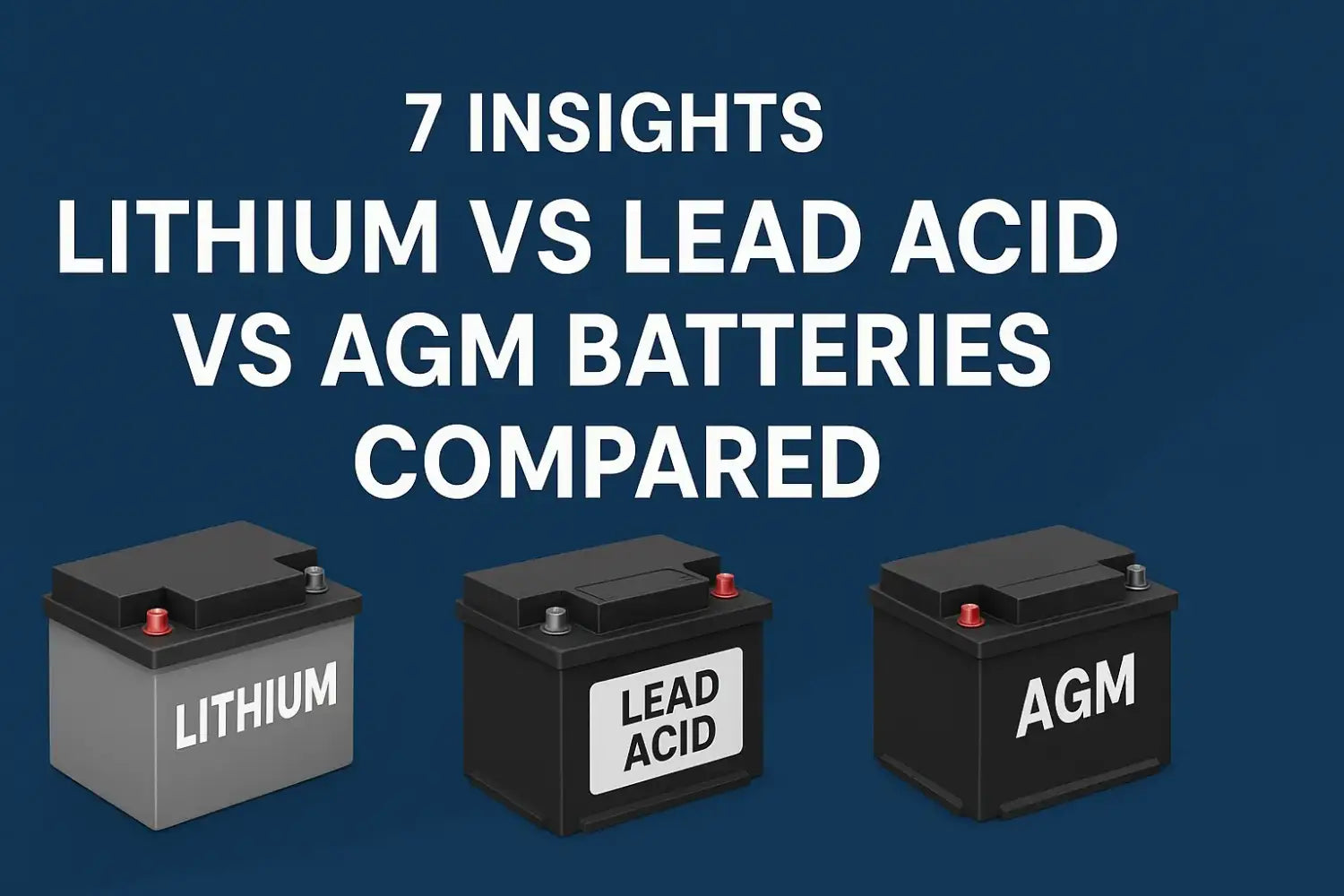
7 Insights: Comparing Lithium, Lead Acid & AGM Batteries

Introduction
Choosing the right batteries is vital for performance and reliability. This guide compares three main battery types—lithium, lead acid, and AGM. Our lithium vs lead acid; battery comparison helps UK buyers make confident, informed decisions. We also include links to trusted product pages and manufacturer information for deeper insight.
Understanding the Types of Batteries
Lead Acid
Lead acid batteries are traditional and proven. They are widely used for vehicles, backup systems and solar storage. However, they are heavy, require maintenance, and offer limited depth of discharge.
AGM (Absorbent Glass Mat)
AGM is a sealed type of lead acid battery. It uses a fibreglass mat to hold the electrolyte. It reduces maintenance and allows flexible installation. Yet, AGM shares many of the same limitations as conventional lead acid.
Lithium (LiFePO₄ and similar)
Lithium batteries represent modern energy storage. They offer deep discharge, fast charging, and long cycle life. Cegasa’s lithium modules offer a comprehensive look at advanced battery technology, combining efficiency with innovative design. For more specialized applications, their E-Bick modules provide flexible, high-performance options. Meanwhile, Victron’s lithium and AGM batteries are known for their reliability and long-lasting performance, making them a solid choice for a variety of energy needs.
Lithium vs Lead Acid; battery comparison – Pros and Cons
Up-front investment and longevity
Lead-acid and AGM cells are simple to install and initially affordable, but they have shorter lifespans. Lithium cells typically last much longer, delivering thousands of charge cycles before noticeable decline. This difference can make lithium more cost-effective over time.
Depth of discharge and usable energy
Lead acid and AGM batteries can only discharge to about half their total capacity without harm. Lithium can often reach 90 percent or more. That means you can draw more usable energy from the same rated capacity.
Efficiency and self-discharge
Lithium batteries are far more efficient. They lose little energy during charge or discharge. They also hold charge longer when idle. Lead acid types tend to self-discharge faster and require regular top-ups if unused.
Weight and energy density
Lithium technology stores more energy in a smaller, lighter package, which is especially important for mobile or space-constrained applications. Lead-acid cells are heavier and bulkier for the same capacity.
Maintenance and safety
Flooded lead acid batteries need periodic water checks and proper ventilation. AGM is sealed but still requires cautious handling. Lithium batteries, when protected by a Battery Management System (BMS), are maintenance-free and safer in controlled environments.
Cycle life and total ownership
Lead-acid cells may last only a few hundred cycles under deep discharge, while AGM versions last slightly longer. Lithium cells often deliver several thousand cycles. This extended lifespan reduces replacement frequency and waste, and studies show that lithium’s lifetime cost per usable kilowatt-hour is significantly lower.
AGM vs lead acid – middle ground or compromise?
AGM batteries sit between flooded lead acid and lithium options. They remove the need for fluid maintenance and allow more flexible placement. However, they still have similar weight, discharge limits, and shorter lifespan. If you need sealed operation but have limited budget or moderate usage, AGM can be practical. For high-cycle or demanding environments, lithium delivers far greater long-term performance.
Real-world cost over time
When analysing lithium vs lead acid; battery comparison over years, lithium generally wins on value. It needs fewer replacements and less downtime. Its deeper discharge and higher efficiency translate into better energy output per lifetime. Although the initial spend is higher, total ownership cost is typically lower. For anyone planning long-term storage or renewable integration, lithium offers a reliable and future-proof investment.
Environmental impact
Lead-acid cells contain more toxic materials and require careful recycling. Lithium cells have cleaner chemistry and greater recyclability potential. Their longer life also reduces waste and transport emissions. Responsible recycling partners in the UK can safely process both types, but lithium has a lower overall environmental impact.
Which should you choose?
Lead acid is suitable for basic, low-use backup systems. AGM offers a good balance for sealed operation and moderate cycling. Lithium is ideal for deep cycling, renewable systems, and long-term value.
For most modern UK installations, lithium provides better performance, lower maintenance, and improved lifespan. Explore high-quality options such as Cegasa lithium modules at Akiva Tech and Victron batteries at Akiva Tech to match your needs.
Conclusion
In this lithium vs lead acid; battery comparison, lithium clearly offers superior cycle life, efficiency, and energy density. Lead acid and AGM remain useful where budget or simplicity matter. However, when total performance, reliability, and long-term cost count, lithium is the smarter choice for UK users.
Explore more from trusted manufacturers like Cegasa and Victron through Akiva Tech’s UK product range to find your ideal energy storage solution.
